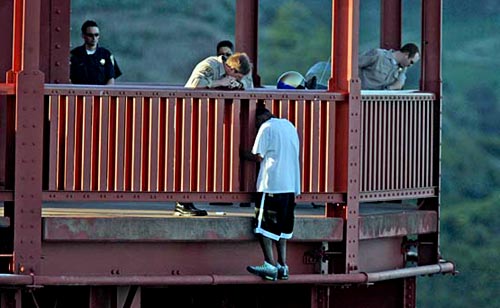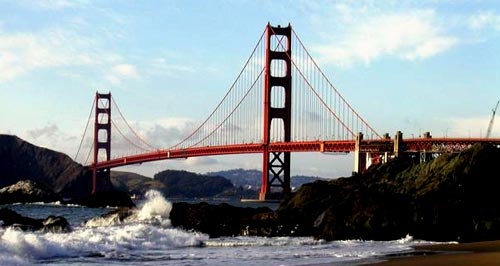
A young man is talked out of jumping off the Golden Gate Bridge
by a California Highway Patrol officer

The Golden Gate Bridge
Golden Gate Bridge Suicides:
Horrible Deaths that are Preventable
by Kevin Caruso
February 22, 2007
“Everyone is better off without this fat, disgusting, boring girl.”
Marissa Imrie was just 14 when she wrote those words as part of her suicide note.
Later that day, Marissa jumped to her death from the Golden Gate Bridge.
She is one of some 1,300 individuals who have died by suicide by jumping from the Golden Gate Bridge. We lose one person about every other week to the waters below, as the bridge somehow holds an allure to people who are suicidal.
Unfortunately, it is exceedingly easy to jump from the bridge. The rail is a mere 4-feet high, and thus virtually anyone can step over it in a second.
But why is the rail so low?
Answer: Because Joseph Strauss, the chief engineer of the bridge, was five feet tall and he wanted to be able to see over the rail, and thus changed the original planned height from 5½ feet to 4 feet.
But regardless of the original height of the rail, why hasn’t a suicide barrier been built? That is, why haven’t they built a high fence that is very difficult, or next to impossible, to climb?
Answer: There have been seven previous attempts at a suicide barrier, but the bridge bureaucracy precluded any of the plans from actually being implemented. An eighth attempt is currently underway.
It is appalling that the barrier was not put in place long ago, but arguments about aesthetics, bridge structure, and money have caused an endless morass to the blindingly obvious problem, which is this: The bridge is the equivalent of an easily-accessible, loaded handgun for countless suicidal individuals, and someone needs to take the damn gun away…and that is done by building a suicide barrier.
The situation has ALWAYS been urgent.
Back in 1937, when the construction on the Golden Gate Bridge was completed, no one envisioned that it would become one of the major suicide sites in the world.
But the suicides began almost immediately. In August of 1937, Harold Wobber, a veteran of World War I, strolled along the pedestrian walkway on the Golden Gate Bridge, paused, looked at a stranger and said, “This is as far as I go.” He then jumped to his death.
And to the mentally ill individuals who go to the bridge, a jump to the water below seems like a peaceful way to end to their pain.
But it is anything but peaceful. It is horrible beyond the most terrifying nightmares that anyone could envision.
And there is no turning back after the jump. It is almost sure death. And an ugly death at that.
It is all physics after the fall begins, as gravity takes hold – the falling body quickly accelerates to some 75 miles per hour and then slams into the water like a truck smashing into a brick wall.
The four-second, 250-foot plunge from the bridge to the water ends quickly and violently.
Bones shatter, ribs are snapped like they were twigs, internal organs are ruptured, blood gushes out of bodily orifices, and the body keeps going down, deeper and deeper, into the hellish water.
For those still alive, the plunge to the frigid water has decimated their body, but now they are so deep underwater that they drown.
And the pain is unbearable.
Hell no, there is nothing peaceful or pretty. It is absolutely horrible. Every second of it is horrible…terrifying, ugly, and sickening.
And that pain will be seemingly insignificant compared to the lifelong pain that the survivors will now endure.
By the way, sometimes the bodies are not even recovered, but when they are, what is left is a horrible sight.
And then the phone calls…Mrs. [fill in the name], this is officer [fill in the name]. I am very sorry to inform you that your daughter is dead…[you don’t want to hear the rest].
So for those who are suicidal and thinking about making a trip to San Francisco to jump, let me give you some heartfelt advice…
Wake the fuck up.
Now.
Acute suicidal feelings RARELY last a long time. Getting treatment, however, can help dissipate your suicidal feelings and help you find the CAUSE of the suicidal feelings.
And when you find the CAUSE, you can receive treatment.
Untreated depression is the number one cause for suicide. And over 90% of people who die by suicide have a TREATABLE mental disorder at the time of their suicide.
There is help.
Call a suicide hotline NOW if you are suicidal, and get help.
Jumping from the Golden Gate Bridge, or ANY bridge, is an ugly, horrible thing to do.
So get help.
Again, if you are suicidal, you MUST call a suicide hotline now and get help; and you MUST see a doctor and get into therapy.
If you are not acutely suicidal or do not need to call a suicide hotline, keep reading.
And let me tell you about Kevin Hines. He has bipolar disorder, which is a VERY treatable disorder.
But without effectual treatment, the disorder can lead to suicide.
It was in September of 2000 when Kevin was in high school and he started to hallucinate and hear voices because of his disorder. After a while, he couldn’t cope any longer, and one day when the hallucinations and voices were particularly intense, he decided to kill himself.
So he took a bus to the Golden Gate Bridge. He cried the entire trip, knowing that his life would soon be over, but also believing that he had to kill himself to end his torment.
“I had heard that the Golden Gate Bridge was the easiest way to die. I heard that you hit the water and you're dead,” Kevin said. “And I remember picking the spot. This is the good spot. I'm not too close to the pillar. I won't hit the pillar. I'm not too close to the land. I won't hit the land. I'll hit the water and I'll die.”
Kevin was ready to kill himself.
But as he walked along, some indecisiveness crept in. He wanted someone to help him; he wanted someone to show him that he or she cared.
So he began crying as he walked, silently reaching out for help.
A female police officer rode by on a bicycle, but did not stop.
Two bridge workers also passed him without stopping.
The voices in Kevin’s head were now screaming at him in a cacophonic chorus: “You have to die!”
But something kept holding Kevin back.
“If someone just showed me that he or she cared,” he thought to himself, “I wouldn’t jump.”
And then an attractive young woman appeared, and Kevin knew that his prayers had been answered.
“She cares,” Kevin said to himself. And he knew that he didn’t have to jump. Everything was okay.
Kevin looked intently at the woman as she approached.
But the woman aloofly handed Kevin a camera and said, “Take my picture.”
Kevin couldn’t believe it. So he stood there crying, took the picture, and was completely convinced that no one cared about him – no one cared whether he lived or died.
He gave the camera back to the woman, took three running steps, and jumped.
But the second that he jumped, he knew that he had made a grave mistake.
“Oh, my God,” he thought to himself. “I don't want to die. What did I just do?”
He wanted to survive. Like a brutal slap in the face, the jump woke him up, but now he was falling head first to his death.
He quickly thought of three things that he needed to do to save himself. First, he asked God to save him. Second, he threw his head back. And third, he struggled to position his legs so that his feet would hit first.
BAM.
The brutal impact shattered Kevin’s body. But he did hit feet first, and at somewhat of an angle, so he was “lucky.”
Well, “lucky” to a degree. He survived, but he broke his back and will forever be deeply physically and emotionally scarred and handicapped by his horrific ordeal.
Kevin is one of 26 known people to survive the deadly jump.
Filomeno De La Cruz, 33, was not so “lucky.” He was deeply depressed because he was going through a divorce and child custody battle. So, on Thanksgiving Day in 1993, he took his 2-year-old son to the bridge, cradled him in his arms, and jumped.
They were both killed.
In 1980, Robert Blyther, 27, a Navy veteran, flew from Virginia to see the bridge, and then to jump off of it.
He also died.
Mark Finch, 33, was suffering from severe clinical depression. He was in the process of coming off of an antidepressant when he jumped to his death.
Lois Ann Houston, 75, felt there was nothing left to live for when she jumped.
She was yet another fatality.
If a suicide barrier was in place, the vast majority of Golden Gate Bridge suicides would have been prevented.
And for those who think that people will just go elsewhere and kill themselves if a barrier is constructed, you are wrong.
A 1978 study by Richard Seiden showed that people who are stopped from jumping from the bridge rarely die by suicide at a later juncture by using another suicide method. Seiden studied 515 individuals who were stopped from jumping from the bridge, and an astounding 94 percent were either still alive or had died from natural causes some 25 years later.
The Empire State Building and the Eiffel Tower have put suicide barriers in place, and have virtually eliminated suicides from their structures.
But a barrier is still just “being considered” for the Golden Gate Bridge.
The Building and Operations committee, which is the administrative panel that oversees the bridge, needs to find something that works and implement it.
Period.
No more bureaucratic bullshit.
No more suicides.
This is not a difficult thing to do, but is one more example of how bureaucracy and misaligned priorities can kill people.
And in this case, it is suicidal people who are looking for help who can be killed.
Yes, they are looking for help, but they rarely find it when they go there; they instead find a tall and beautiful bridge, with a 4-foot rail.
The only thing missing is a sign that reads, “Jump.”
Put up the suicide barrier now.

The Golden Gate Bridge at sunset
If you or someone you know is suicidal, please go to the Home Page of this website for immediate help.
Thank you.
I love you.
Take care,
Kevin Caruso
